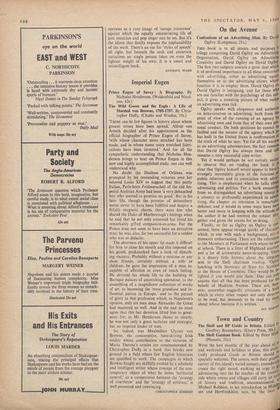Town and Country
The Shell and BP Guide to Britain. Edited by
(Phoenix, 21s.)
Wax the best months of the year ahead of '15 and weekends and holidays to plan, this attrsc' tively produced Guide to Britain should be specially welcome. The covers, with their graf survey of this island's varied scenery, immediately create the right mood, evoking an urge 1° o adventuring into the far reaches of the country side where towns and villages still carry an attr of history and tradition, uncontaminated, .5 Michael Robbins, in his introduction to Mid' sex and Hertfordshire, says, by 'the mess
brick, concrete, wires and gaudy lights that creeps like an eczema outwards from the great cities of Britain.'
Forty-eight sections are devoted to the counties of England, Wales and Scotland, each heralded by a decorative colour-plate proclaiming its special features, followed by an introduction written by an authority who, knowing it inti- mately, reveals its past and present with a persuasiveness that makes us wish to see it for ourselves—or see it again, as the case may be. Each section has its gazetteer of places and sights worth seeing, many excellent photographs and a list of local houses and gardens that are open to the public.
Though visiting other people's gardens is one of the chief pleasures of summer excursions, it is one that can be immeasurably increased by improving our knowledge of the men and the influences that created them. The long-felt want of a really comprehensive guide to British gardens and the history of gardening has now been supplied by the lavishly illustrated Shell Gardens Book compiled by a team of experts. It is rich in content, entertainingly written and a handy size to take around; we could not wish for a better companion. The development of the garden as a work of art is traced from the six- teenth century, when Thomas More at Chelsea laid out a garden 'of marvellous beauty, full of lovely flowers and blossoming trees,' with much absorbing detail about changing styles and trends.
Here we can read how the simple walled en- closures of that period, with their espaliers and prim flower knots, were replaced, under the in- fluence of French designers in the seventeenth century, by vast formal layouts of intricately planned parterres embellished with fountains and statuary. These in their turn were swept away in the eighteenth century by a new generation of gardeners who turned to nature for guidance and landscaped their gardens and parks. Other chapters are devoted to the plants themselves, to the travellers who risked their lives to find them, and to great gardeners and their patrons.
ELISABETH INGLIS-JONES















































 Previous page
Previous page